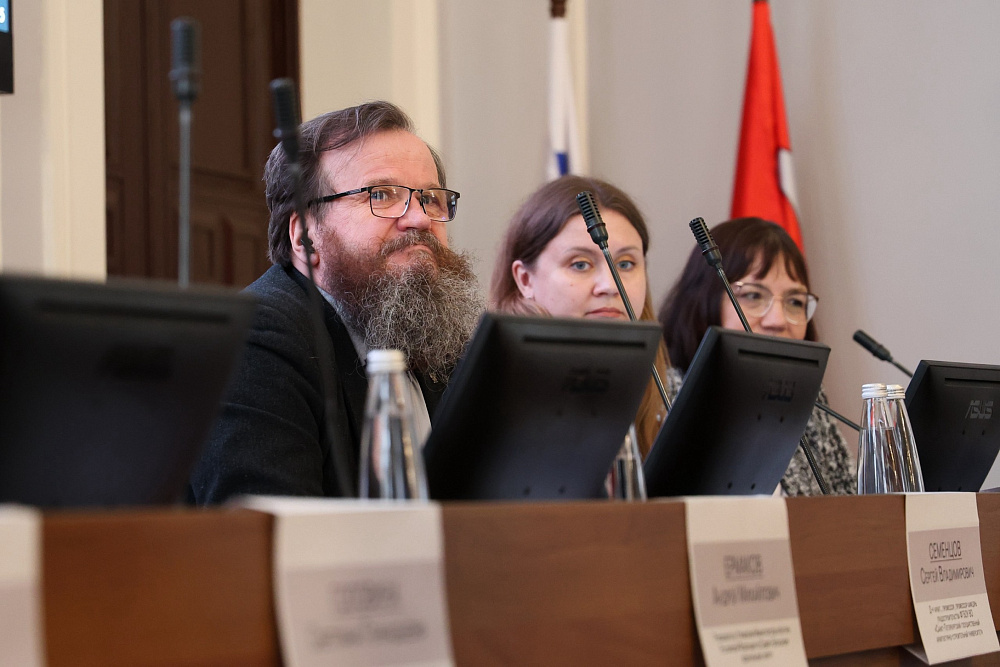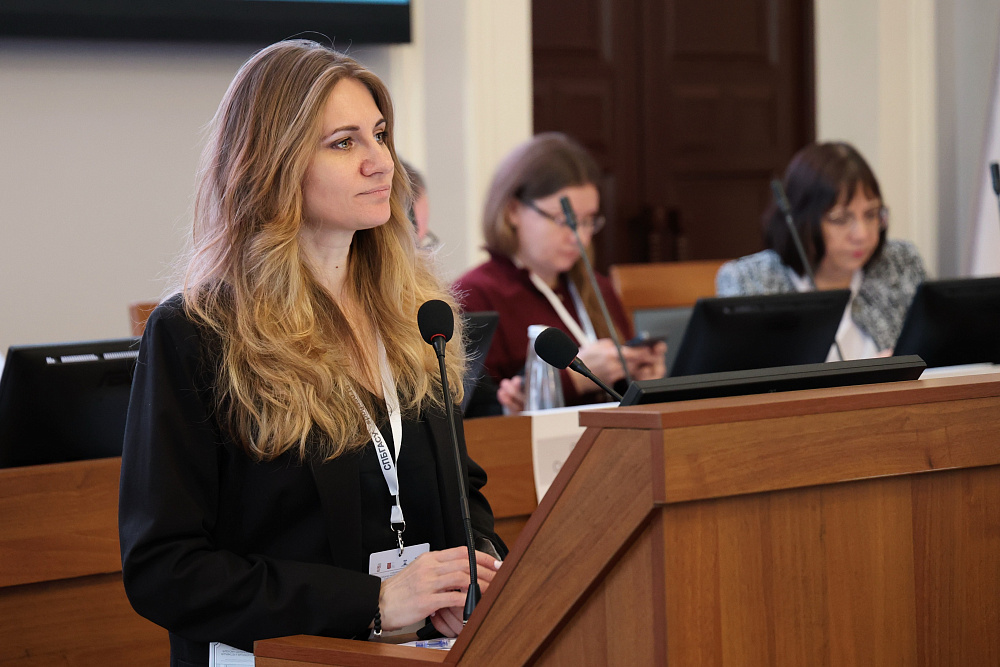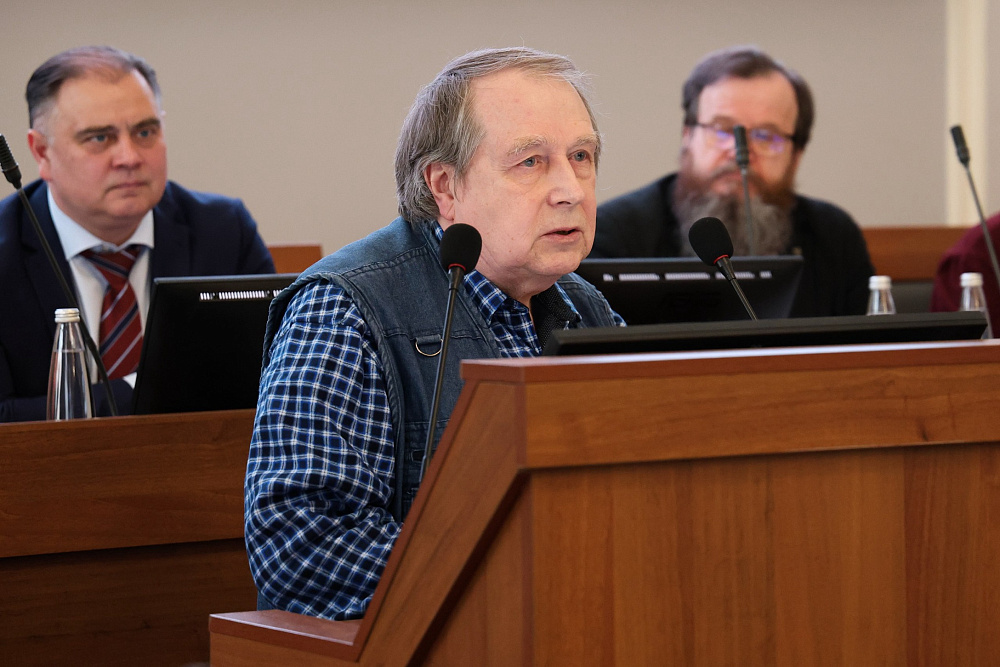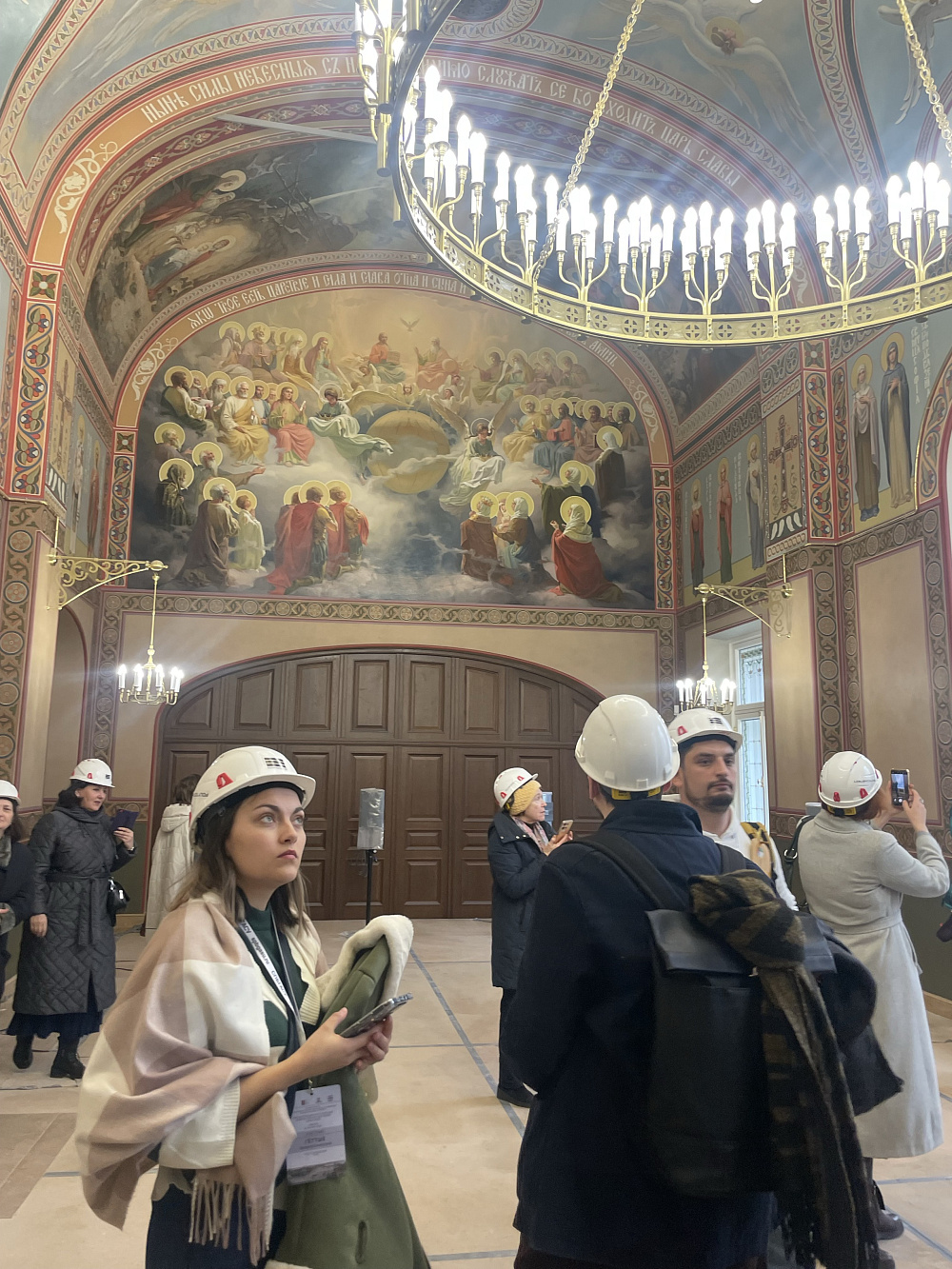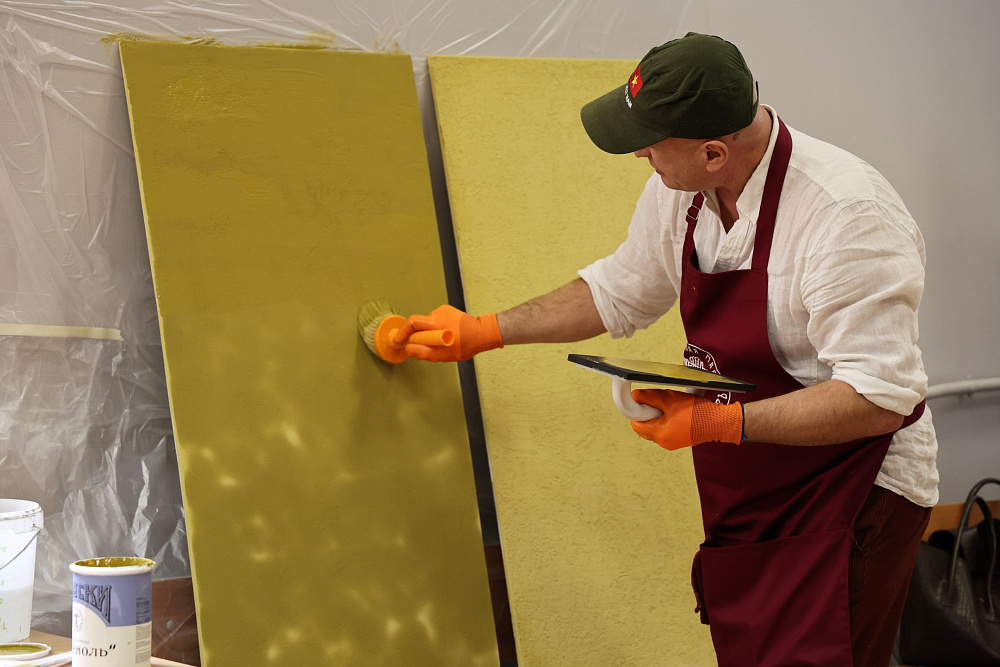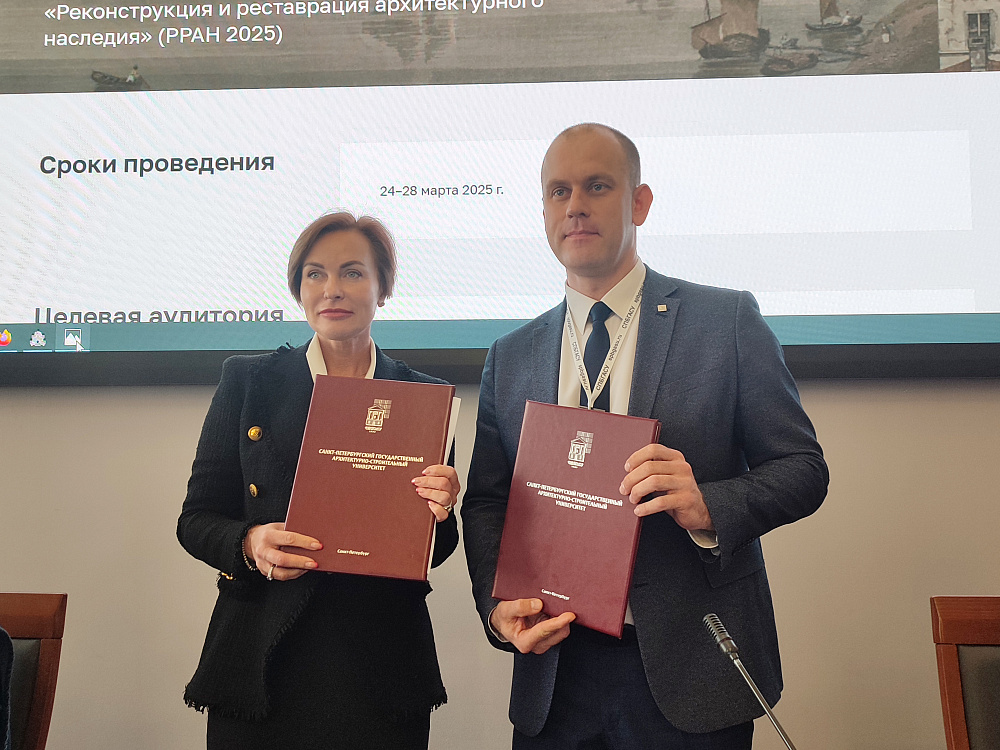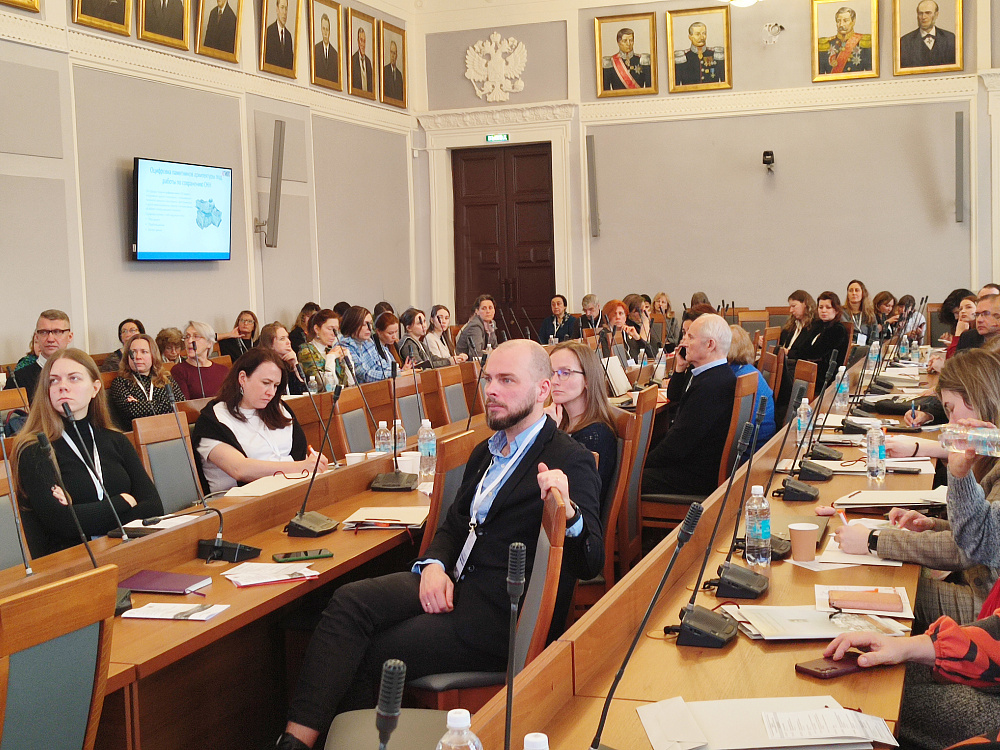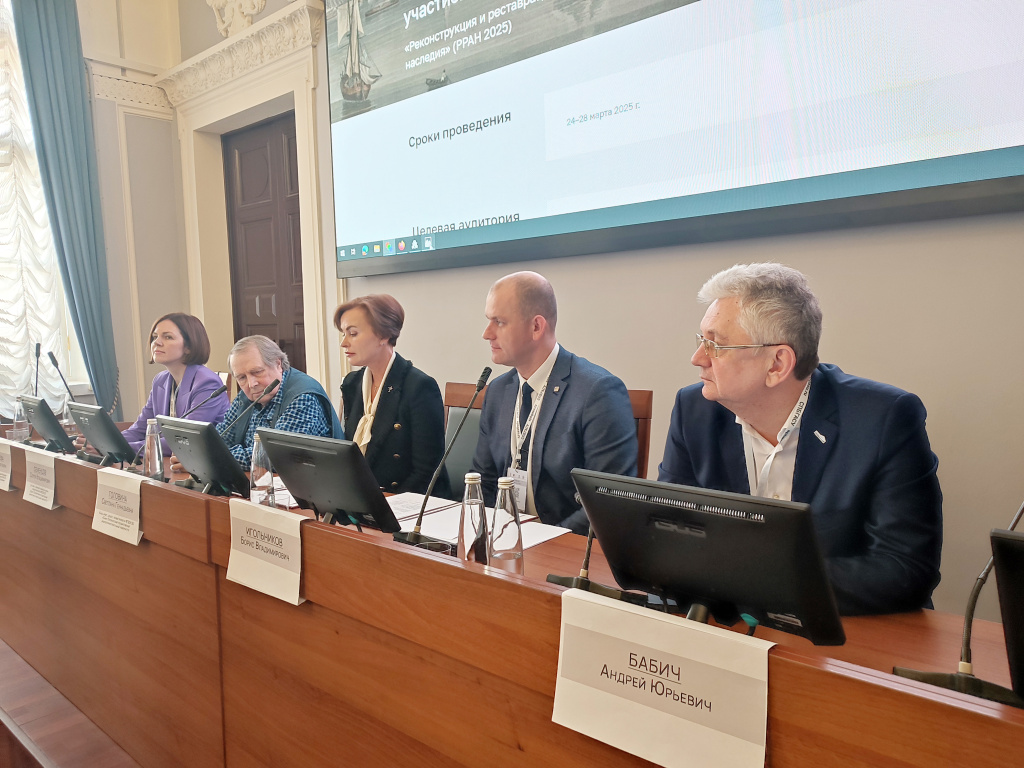 Presidium of the round table "Additional professional education in restoration". From left to right: Chairperson of the Russian Association of Restorers, Acting Director of the State Autonomous Cultural Institution of the Leningrad Region "International Restoration Center" Tatiana Chernyaeva; Professor at the SPbGASU Department of Urban Planning Sergey Sementsov; SPbGASU First Vice-Rector Svetlana Golovina; Director of the Higher Engineering School of RUT (MIIT) Boris Igolnikov; General Director of REMMERS LLC Andrey Babich
Presidium of the round table "Additional professional education in restoration". From left to right: Chairperson of the Russian Association of Restorers, Acting Director of the State Autonomous Cultural Institution of the Leningrad Region "International Restoration Center" Tatiana Chernyaeva; Professor at the SPbGASU Department of Urban Planning Sergey Sementsov; SPbGASU First Vice-Rector Svetlana Golovina; Director of the Higher Engineering School of RUT (MIIT) Boris Igolnikov; General Director of REMMERS LLC Andrey Babich From 24 to 28 March, the Saint Petersburg State University of Architecture and Civil Engineering held the anniversary 5th National (All-Russian) scientific and practical conference with international participation “Reconstruction and Restoration of Architectural Heritage” (RRAH-2025).
The conference was attended by representatives of the Russian Ministry of Culture, state bodies for the protection of monuments, higher education institutions training architect-restorers, restoration specialists from all over Russia and abroad. The partners of the conference were the Committee for State Control, Use and Protection of Historical and Cultural Monuments (KGIOP) of the Government of St Petersburg and the Non-Commercial Partnership "Russian Association of Restorers (Rosregionrestavratsiya)". The conference was held with the participation of the companies "Fridlender Paints", OOO "REMMERS" and OOO "RUNIT".
Plenary session
The plenary session “Features of preservation and development of restoration professions” discussed prospects for cooperation, outlined development paths for the industry, and discussed new challenges facing restoration architects.
Mikhail Mamoshin, chief architect and project manager at Mamoshin Architectural Workshop LLC, spoke about the reconstruction of the Church of the Holy Blessed Princes Boris and Gleb in St Petersburg. The church was built in 1866–1882 and operated until 1934. Then, for over 40 years, it was used for other purposes, and in 1975, the building was demolished to make way for a new route for the Sinopskaya Embankment. Interest in the reconstruction of this site arose after the publication of an album dedicated to the lost churches of the Northern capital, which was prepared at the SPbGASU Department of Architectural and Urban-Planning Heritage by Professor Sergey Vladimirovich Sementsov and Associate Professor Nadezhda Aleksandrovna Akulova. Later, the Foundation for Assistance to the Restoration of Historical and Cultural Sites in St Petersburg, with the support of the Union of Architects of St Petersburg, published the book “The Lost Churches of St Petersburg”. In 2019, the foundation announced its decision to recreate this temple. The team led by Mikhail Mamoshin was entrusted with carrying out the design work.
Yulia Bogacheva, Deputy Chairperson of the Committee for State Control, Use and Protection of Historical and Cultural Monuments, gave a report "Heritage protection and digitalization". The audience learned about the KGIOP archive, the funds of which were formed in the 1930s and include documents from the beginning of the 18th century to the present day. In 2015–2017, 2,700 storage units were digitized and placed in the committee's information system. Yulia Olegovna reviewed the main digital systems and technologies used in the implementation of control (supervisory) activities, and emphasized the need for a modern comprehensive solution integrated with regional and federal geographic information systems (GIS). According to the speaker, digital transformation is impossible without the creation of a geographic information system of cultural heritage sites (CHS GIS). The implementation of the project will improve the quality and efficiency of recording, identifying, preserving, using, popularizing and state protection of cultural heritage sites (historical and cultural monuments) in St Petersburg, and automate information exchange. The KGIOP representative also spoke about plans to develop solutions based on information regulation technologies (IRT) together with SPbGASU for analyzing and assessing the condition of architectural monuments, monitoring the condition of monuments, etc.
Ekaterina Tribelskaya, Head of the Department of Architecture at the Moscow State Academic Art Institute named after V. I. Surikov at the Russian Academy of Arts, presented the Faculty of Architecture of her university, noting that they are attentive and careful about preserving cultural heritage sites, and research them as part of coursework and diploma theses.
Anna Smirnova, CEO of Fridlender Paints LLC, gave a presentation "Brand cities. Cultural heritage and identity in historical cities." The speaker listed the reasons why a city needs its own brand: this will attract investment and tourists, support traditions, create conditions for business development, and much more. In addition, this will preserve important historical foundations of color perception and preserve the identity of the environment.
Yulia Yankovskaya, Head of the SPbGASU Department of Urban Planning, gave a report entitled "Compositional and artistic aspects of architectural and urban planning design - history and modernity." Yulia Sergeevna said that the Russian architectural school had always focused on compositional and artistic training. This is our global brand, which our Western and Eastern colleagues are guided by. Its outstanding representatives worked at SPbGASU - Yuri Kurbatov (1934-2020) and Vladimir Antoshchenkov (1933-2024). Unfortunately, according to Yulia Yankovskaya, this brand has recently begun to lose ground.
In her presentation, Yulia Sergeevna showed the evolution of compositional training in architecture and architectural education and the development of ideas about extra-leftist form-building in the 20th–21st centuries, emphasizing that this is also a legacy that needs to be known, preserved and developed.
In addition, Yulia Sergeevna drew the attention of the audience to two new topics discussed at the conference. One of them is monumental art in architecture and urban development. This topic was the subject of a round table and an exhibition at the Faculty of Architecture, which will last until 4 April.
The conference program, in addition to five main sections in a number of areas, also included two round tables, two master classes, a lecture block, and two days of visiting restoration sites in St Petersburg and its suburbs.
Round table "Additional professional education in restoration"
The round table began with a ceremony to sign an agreement on interuniversity cooperation between the Russian University of Transport and SPbGASU. The document was signed by Boris Igolnikov, Director of the Higher Engineering School of the Russian University of Transport (RUT (MIIT)) and Svetlana Golovina, First Vice-Rector of SPbGASU.
The parties intend to exchange experience and information, organize internships for students and postgraduates, and hold joint events. Boris Igolnikov reported that the two universities were already actively interacting. The signing of the agreement will allow this interaction to reach a new level.
Round table "Architecture, art, technology - integration mechanisms in a historical city"
The attention of the participants of the round table “Architecture, art, technology – integration mechanisms in a historical city” was focused on the digitalization of architectural and urban planning activities, which is being actively implemented at the state level, and its impact on the creative process of the architect and artist.
Those gathered also considered the role of the architect-restorer, the architect-urban planner, who combines the compositional-artistic historical and creative principles, which are important to take into account when preserving and developing the environment, which is especially important when designing and organizing space and allows for the life of a modern person.
Participants noted the need for proper management of this process, the inclusion of an urban architect and a restoration architect, the need to correctly set boundaries between areas where digitalization is important and necessary, and those where creative search remains a priority.
Section "Experience of practical restoration and modern materials (synthesis of science and practice)"
At the section "Experience of practical restoration and modern materials (synthesis of science and practice)", participants presented modern technologies for adapting architectural monuments, ensuring the possibility of their effective and safe operation, taking into account modern requirements. Aleksey Kharitonov, Associate Professor at the SPbGASU Department of Technology of Construction Materials and Metrology, moderator of the section, reported that these technologies provide for minimal intervention in historical structures and materials, as they are based on the continuity of traditional construction techniques.
"We exchanged experience in selecting restoration materials and technological schemes for conducting work using completed projects as an example. The participants were very interested in discussing the problem of capillary water suction in brick walls: completely new and scientifically substantiated ideas about the mechanism of moistening the walls of buildings and structures made of brickwork were presented. Draft national standards were presented, designed to regulate the requirements for the quality of work on the restoration of brickwork and plaster finishing," said Aleksey Kharitonov.
Section "Monumental art in urban planning"
At this section, experts discussed the issues of integrating monumental art works into architecture and urban planning. If this process is well-established within the framework of restoration and reconstruction of historical monuments, then when including such works of art in modern architecture, the interaction between the architect and the monumental artist is often insufficient. Experts see the reason for this in the exclusion of this aspect from the educational process of architectural and artistic and architectural and construction universities. As a consequence, there is a lack of cooperation skills and, moreover, an understanding of the role of monumental art in modern architecture and the urban environment.
"Our colleagues from the Department of Architecture at the Moscow State Academic Art Institute named after V. I. Surikov told us about training in this type of interaction (work between architects and sculptors as part of a third-year course project and a diploma project (in the latter case, it is optional)). Such interaction is not observed in other educational institutions, so the initiative of the SPbGASU Department of Urban Planning to include the works of students of monumental painting in projects to transform the urban environment is very important. It is necessary to develop this area both in object design and in architectural-environmental and urban development design," said Yulia Yankovskaya, moderator of the section.
Master classes
The highlights of the conference were the master classes from the company "Fridlender Paints": "Lime paint as part of a systematic approach to restoration based on the principle of "like to like"" and "Restoration of brick and stonework". Experienced professionals demonstrated their work on restoring the surfaces of architectural monuments, shared advice on working with materials and tools, and original paint application techniques.
The construction company REMMERS presented an exhibition stand at the conference, telling about its restoration projects, and the magazine "Restoration bulletin", which it publishes. The publication was of great interest to the conference participants and students of SPbGASU.
Visiting restoration sites
Thematic excursions were organized for the conference participants. In the Yusupov Palace on the Moika Embankment, they viewed the state interiors that had recently undergone restoration. In the building of the St Petersburg Conservatory, they got acquainted with the progress of the restoration work that was being completed. They viewed restoration objects in one of the palace and park suburbs of St Petersburg – in Peterhof.
During the conference, specialists were also able to undergo advanced training.
Those gathered came to a general consensus on the need to create a single center for the development of restoration technologies.
The conference results will be published as a collection of scientific articles.







